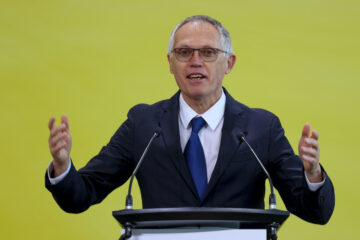Check back for updates throughout the trading day
U.S. equity futures looked to rebound from yesterday’s brutal selloff in early Tuesday trading, with Treasury bond yields moving higher amid selling in safe-haven assets, as investors cautiously returned to risk markets while eyeing the causes of Monday’s global rout.
The S&P 500 and the Nasdaq suffered their biggest single-day declines in more than two years yesterday, with the benchmark falling 3% and the tech-focused index shedding 3.4% by the close of trading.
The Dow Jones Industrial Average, meanwhile, gave back more than 1,000 points by the end of the heavy-volume trading day, extending its decline to around 5% over the past three sessions, which saw market volatility levels surge to the highest in more than four years.
The CBOE Group’s VIX index, the market’s benchmark gauge, fell 43.65% in overnight trading to a level of $33.60, but that still suggests daily swings of around 2.1%, or 108 points, for the S&P 500 over the coming month.
Japan’s Nikkei 225 notched a healthy rebound Tuesday, but remains around 1,000 points shy of recouping Monday’s wipeout.
A massive rebound last night in Japan, where the Nikkei 225 ended 10.2% higher on the session, clawing back some of Monday’s 12.4% collapse, as well as normalized trading in the Treasury market has investors feeling more confident that the ‘yen carry trade’ was the most likely culprit to yesterday’s rout.
Investors who borrowing at near-zero rates in Japan, only to convert their yen holdings to dollars and buy U.S. assets, were caught out by two Bank of Japan rate hikes and a massive move higher in the currency.
Related: Black Monday on Wall Street: 5 reasons stocks are plummeting
Chasing those moves to recover their losses forced wholesale selling in the U.S., as well as other markets, during yesterday’s declines.
Markets are now likely to return their focus to the Federal Reserve’s rate path, following last week’s weaker-than-expected jobs data that sparked bets on a 50 basis point rate cut from the central bank’s next meeting in Septemer.
San Francisco Fed President Mary Daly alluded to that reality during an event in Hawaii last night, telling the audience that it’s clear inflation is coming down closer to our target (and) it’s clear that the labor market is slowing and it’s to a point where we have to balance those goals.
The CME Group’s FedWatch suggests an 80.5% chance of a 50 basis point rate cut in September, with reductions priced in for the final two Fed meetings of the year in November and December.
In the bond markets, benchmark 2-year Treasury note yields rose to 3.951% in overnight trading, with 10-year note yields pegged at 3.841%.
Related: Jobs report triggers key recession warning signal as stocks plunge
On Wall Street, futures contracts tied to the S&P 500, which lost 152 points in yesterday’s session, are priced for a 26 point opening bell gain.
Futures linked to the Dow, meanwhile, suggest a modest rebound of around 80 points, with the Nasdaq called 82 points higher.
In overseas markets, Europe’s Stoxx 600 was marked 0.31% lower in Frankfurt, suggesting markets remain jittery heading into the U.S. session, with Britain’s FTSE 100 down 0.21% in London.
More Wall Street Analysts:
Analysts reboot Amazon stock price targets after earningsAnalyst reboots Rivian stock price target on updated plansAnalysts reboot Arm Holdings stock price target following
Overnight in Asia, Japan’s Nikkei 225 ended 10.2% higher, but was still 1,000 points short of yesterday’s 12.4% wipeout by the close of trading.
The regional MSCI ex-Japan benchmark, meanwhile, was marked 1.06% higher heading into the final hours of the trading session.
Related: Veteran fund manager sees world of pain coming for stocks


